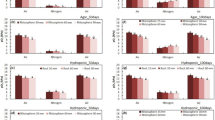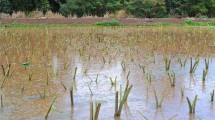Abstract
Aerenchyma gas spaces are important for plants that grow in flooded and anaerobic sites or habitats, because these gas spaces provide an internal pathway for oxygen transport. The objective of this study is to characterize the development of aerenchyma gas spaces and observe the porosity in roots of Sonneratia alba. Tissue at different developmental stages was collected from four root types, i.e. cable root, pneumatophore, feeding root and anchor root, of S. alba. In S. alba, gas space is schizogenously produced in all root types, and increases in volume from the root meristem to mature root tissues. The aerenchyma formation takes place immediately, or 3–5 mm behind the root apex. At first, cortical cells are relatively round in cross sections (near the root apex); they then become two kinds of cells, rounded and armed, which combine together, forming intercellular spaces behind the root apex. The average dimensions of cortical cells increased more than 1.3 times in the vertical direction and over 3.3 times in the horizontal direction. At maturity, aerenchyma gas spaces are long tuberous structures without diaphragms and with numerous small pores on the lateral walls. Within the aerenchyma, many sclereids grow intrusively. Root porosity in all root types ranged from 0–60%. Pneumatophores and cable roots had the highest aerenchyma area (50–60%).





Similar content being viewed by others
References
Allaway WG, Curran M, Hollington LM, Ricketts MC, Skelton NJ (2001) Gas space and oxygen exchange in roots of Avicennia marina (Forssk.) Vierh. var. australasica (Walp.) Moldenke ex N.C. Duke, the grey mangrove. Wetland Ecol Manag 9:211–218
Armstrong W (1979) Aeration in higher plants. Adv Bot Res 7:275–332
Armstrong W, Brändle R, Jackson MB (1994) Mechanism of flood tolerance in plants. Acta Bot Neerl 43:307–358
Ashford AE, Allaway WG (1995) There is a continuum of gas space in young plants of Avicennia marina. Hydrobiology 295:5–11
Campbell R, Drew MC (1983) Electron microscopy of gas space (aerenchyma) formation in adventitious roots of Zea mays L. subjected to oxygen shortage. Planta 157:350–357
Conard HS (1905) The waterlilies: a monograph of the genus Nymphaea. Publ Carnegie Inst 4:1–292
Connel EJ, Colmer TD, Walker I (1999) Radial oxygen loss from intact roots of Halophila ovalis as a function of distance behind the root tip and shoot illumination. Aquat Bot 63:219–228
Curran M (1985) Gas movement in the roots of Avicennia marina (Forsk.) Vierh. Aust J Plant Physiol 12:97–108
Curran M, Cole M, Allaway WG (1986) Root aeration and respiration in young mangrove plants (Avicennia marina (Forsk.) Vierh.). J Exp Bot 37:1225–1233
Hovenden MJ, Allaway WG (1994) Horizontal structures on pneumatophores of Avicennia marina (Forsk.) Vierh.—a new site of oxygen conductance. Ann Bot 73:377–383
Jackson MB, Armstrong W (1999) Formation of aerenchyma and the process of plant ventilation in relation to soil flooding and submergence. Plant Biol 1:274–287
Johansen DA (1940) Plant microtechnique. McGraw-Hill, New York
Justin HFW, Armstrong W (1987) The anatomical characteristics of the roots and plant response to soil flooding. New Phytol 106:465–495
Kaul RB (1971) Diaphragms and aerenchyma in Scirpus validus. Amer J Bot 58:808–816
Kaul RB (1974) Ontogeny of foliar diaphragms in Typha latifolia. Amer J Bot 61:318–323
Laan P, Berrevoets MJ, Lythe S, Armstrong W, Blom CWPM (1989) Root morphology and aerenchyma formation as indicator of the flood tolerance of Rumex species. J Ecol 77:693–703
Maricle BR, Lee RW (2002) Aerenchyma development and oxygen transport in the estuarine cordgrasses Spartina alterniflora and S. anglica. Aquat Bot 74:109–202
Moog PR (1998) Flooding tolerance of Carex species. I. Root structure. Planta 207:189–198
O’Brian TP, Cully ME (1981) The study of plant structures, principle and selected methods. Termacarphi, Melbourne
Sanderson JB (1994) Biological microtechnique. BIOS Scientific, Oxford
Scholander PF, Van Dam L, Scholander SI (1955) Gas exchange in the roots of mangroves. Amer J Bot 42:92–98
Schussler EE, Longstreth DJ (1996) Aerenchyma develops by cell lysis in roots and cell separation in leaf petioles in Sagittaria lancifolia (Alismataceae). Amer J Bot 83:1266–1273
Schussler EE, Longstreth DJ (2000) Changes in cell structure during the formation of root aerenchyma in Sagittaria lancifolia (Alismataceae). Amer J Bot 87:12–19
Seago JL, Peterson CA, Enstone DE (2000) Cortical development in roots of the aquatic plant Potenderia cordata (Pontederiaceae). Amer J Bot 87:1116–1127
Sifton HB (1945) Gas space tissue in plants. Bot Rev 11:108–143
Skelton NJ, Allaway WG (1996) Oxygen and pressure changes measured in situ during flooding in roots of the grey mangrove Avicennia marina (Forssk.) Vierh Aquat Bot 54:165–175
Smirnoff N, Crawford RMM (1983) Variation in the structure and response to flooding of root aerenchyma in some wetland plants. Ann Bot 51:237–249
Sun Q, Kobayashi K, Suzuki M (2004) Intercellular space system in xylem rays of pneumatophores in Sonneratia alba (Sonneratiaceae) and its possible functional significance. IAWA J 25:141–154
Tomlinson PB (1986) The botany of mangroves. Cambridge University Press, Cambridge
Troll W, Dragendorff D (1931) Über die Luftwürzeln von Sonneratia Linn. F. und ihre biologische Bedeutung. Planta 13:311–473
Visser EJW, Bögemann GM (2003) Measurement of porosity in very small samples of plant tissue. Plant Soil 253:81–90
Visser EJW, Bögemann GM, Van de Steeg HM, Pierik R, Blom WPM (2000a) Flooding tolerance of Carex species in relation to field distribution and aerenchyma formation. New Phytol 148:93–103
Visser EJW, Colmer TD, Blom CWPM, Voesenek LACJ (2000b) Changes in growth, porosity, and radial oxygen loss from adventitious roots of selected mono- and dicotyledonous wetland species with contrasting types of aerenchyma. Plant Cell Env 23:1237–1245
Webb J, Jackson MB (1986) A transmission and cryo-scanning electron microscopy study of the formation of aerenchyma (cortical gas-filled space) in adventitious roots of rice (Oryza sativa). J Exp Bot 37:832–841
Youssef T, Saenger P (1996) Anatomical adaptive strategies to flooding and rhizophere oxidation in mangrove seedlings. Aust J Bot 44:297–313
Acknowledgements
We thank Prof. Tokushiro Takaso, Research Institute for Humanity and Nature, Kyoto, and the staff of Iriomote Station, Tropical Biosphere Research Center, University of Ryukyus, for their great support in our field research; Dr. Qiang Sun for helpful comments and criticism on the manuscript. We also thank Kazutaka Kobayashi, Takahisa Tanaka, Youichi Hasegawa, Masanori Seki, and Hiroaki Terasawa for their field-sampling assistance.
Author information
Authors and Affiliations
Corresponding author
Rights and permissions
About this article
Cite this article
Purnobasuki, H., Suzuki, M. Aerenchyma formation and porosity in root of a mangrove plant, Sonneratia alba (Lythraceae). J Plant Res 117, 465–472 (2004). https://doi.org/10.1007/s10265-004-0181-3
Received:
Accepted:
Published:
Issue Date:
DOI: https://doi.org/10.1007/s10265-004-0181-3




